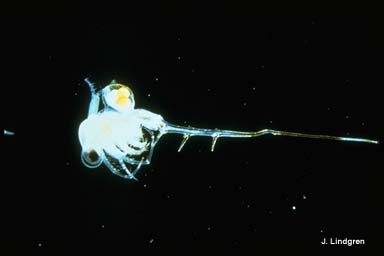
Welcome to our informational site on Threats to Ontario's Waters

The spiny water flea, Bythotrephes (bith-o-TREH-feez) cederstroemi, a small planktivorous crustacean, has an average length slightly larger than 1 centimeter (0.4 inches) of which 70% is a long, sharp, barbed tail spine. First introduced into the Great Lakes ecosystem in 1984 via ballast water that was discharged into Lake Huron, they have spread to all of the Great Lakes by 1987 and currently infect inland lakes in Michigan and Southern Ontario. Their rapid reproduction, general lack of predators and direct competition with young fish for food yields them the potential to alter the food webs of the Great Lakes.
SOURCE: “Spiny Tailed Bythotrephes in the Great Lakes” 1991. The Great Lakes
Sea Grant Network
SLIDE. Lindgren, J. “Single Bythotrephes showing egg sac”, Minnesota DNR
(on NIS site)
Key Words: Bythotrephes
![]()
The spiny water flea is a small (less than 1 cm long) planktonic crustacean that was introduced into the Great Lakes from Europe in the early 1980s. It has spread throughout the Great Lakes, and has invaded the Muskoka Lakes, Lake Simcoe, the Kawartha Lakes, Lake Temagami, and several smaller lakes in central Ontario. The spiny water flea was probably introduced into these inland lakes through recreational boating traffic. The impacts of this invader are unknown, but it might impact fish by disrupting the food chain. Spiny water fleas collect on fishing lines and downrigger cables, and can be transported in bait-buckets and live wells. It only takes one adult or egg to begin an infestation. Please ensure that you thoroughly clean your fishing equipment and boat if you have been in an infested waterbody.